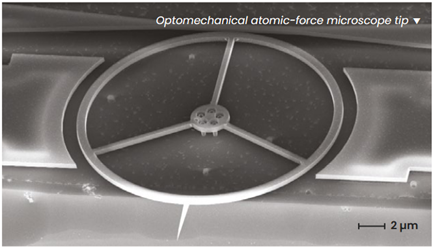LUMIK

Main Features
- Optomechanical technology combining silicon photonics and and high-performance MEMS (Micro Electro-Mechanical Sensors) for motion detection using light.
- Principle based on the interaction between a MEMS resonator and an optical cavity – the movement of a mass generates an intensity variation that allows it to be measured.
- Increased sensitivity, higher speed, and optimized integration compared to traditional capacitive and piezoresistive technologies.
Process Characteristics
- Combination of VLSI (Very Large Scale Integration) optical and mechanical processes
- 200mm wafer size – Grenoble facility (France)
- SOI substrate
- Optical IO patterned by DUV (Deep Ultra-Violet) lithography and formed by dry etching
- MEMS resonator, photonic devices and electrical contacts defined using e-beam lithography and formed by RIE (Reactive Ion Etching)
- 1 AlSi metallization level for polarization and interconnections
- Resonator release by isotropic HF etching
Device Characteristics and key figures
- Minimum feature size of 100nm for both optical & mechanical parts
- Operating optical wavelength of 1550 nm
- Femtometer detection capabilities
- Response rate in the terahertz range
- Scalability of VLSI MEMS and silicon-photonics technologies
Prices
The details about the prices will come soon.
Contact
Design-Kit Content
- Standard cells of basic devices to start a design and illustrate the use of CAD layers
- The standard cell libraries will be gradually extended with each new release of the design kit
CAD Tools
Cadence
- IC (design framework)
Siemens
- Calibre (physical verification)
Usual Application areas
- Portable in-situ mass spectrometry (extreme sensistvity down to viruses and proteins)
- Portable biological sensing (rapidbiomarker detection and sensitvity down to bacteria)
- Real-time atomic-force microscopy (video-rate imaging to observe fast biological process)
- Silicon clocks (quartz-like accuracy for GHz frequency)
- Inertial sensors (precision and compactness)
- Quantum information transfer
- Rheology
Run Dates
- First submission deadline to CIME-P in February 2026 for first run
- More details to come in the near future
Turnaround Time
- 44 weeks for manufacturing

